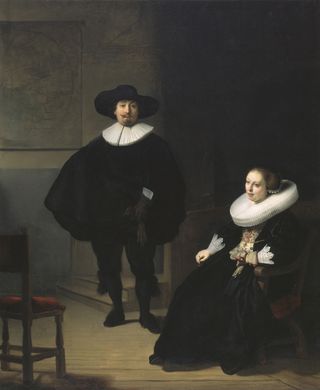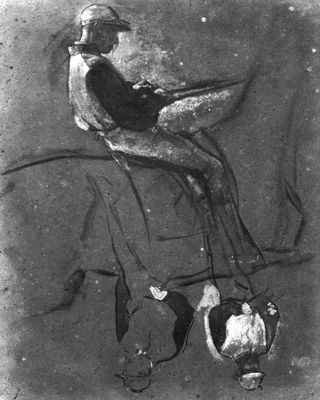Lost Art: Photos of the Paintings Stolen from the Gardner Museum
In the early morning hours of March 18, 1990, a security guard opened a side door at the Isabella Steward Gardner Museum in Boston for two men dressed as police officers. By the time the real police arrived that morning, the guards were handcuffed and bound with duct tape in the basement and 13 works of art were missing.
The art has been valued at $500 million, making the Gardner art heist the biggest art theft – and largest property crime — in U.S. history. To this day, the identities of the thieves remains a mystery, and the art remains missing. Here are the 13 pieces lost on that day in 1990. (Images credit: FBI) [Read the full story on the Gardner art heist]
Rembrandt, The Storm on the Sea of Galilee, 1633

One of the most expensive missing pieces from the Gardner museum is this stormy scene from the Dutch painter Rembrandt. This 1633 work is Rembrandt's only known seascape. This work was stolen from the Gardner museum's "Dutch Room." According to the museum, he man at the bottom of the painting holding his hat and looking out from the canvas is thought to be a self-portrait of Rembrandt.
The art thieves cut this painting from its frame, an act that could have irretrievably damaged it, according to Robert Whittman, a retired special agent who founded the FBI's national Art Crime Team in 2005. The painting was about 63 inches long (160 centimeters) and 50 inches wide (109 cm).
Vermeer, The Concert, 1658-1660

Dutch artist Johannes Vermeer left only a few dozen paintings behind after his death. One of them was "The Concert," stolen in the Gardner heist. According to the museum, this is the most valuable stolen painting in the world. This painting alone is estimated to be worth $200 million. It measures about 27 inches by 25 inches (69 cm by 63 cm) and depicts three musicians at work.
Sign up for the Live Science daily newsletter now
Get the world’s most fascinating discoveries delivered straight to your inbox.
Rembrandt, A Lady and Gentleman in Black, 1633

Also cut from its frame in the Gardner heist was this large work, which measured almost 52 inches tall (132 cm) and 43 inches across (109 cm). "A Lady and Gentleman in Black" hung near Rembrandt's Galilee seascape. Rembrandt painted the piece around 1633.
Manet, Chez Tortoni, 1878-1880

This small oil painting by Édouard Manet disappeared during the Gardner art heist. It depicts a young man writing in a Parisan café and once hung in the museum's Blue Room near another Manet portrait of the artist's mother. Perhaps fortunately, the maternal portrait was being cleaned the night the thieves stalked the museum, plucking paintings from the walls.
Govaert Flinck, Landscape with an Obelist, 1638

Once thought to be a Rembrandt, this moody landscape is actually the work of Dutch painter Govaert Flinck, who counted Rembrandt as one of his inspirations. This painting is oil on wood and measures about 21 inches by 28 inches (54.5 cm by 71 cm). It sat on a table not far from Vermeer's "The Concert," and may have been mistaken as a Rembrandt by the art thieves.
Degas, La Sortie de Pesage

A number of Edgar Degas works fell victim to the thieves at the Gardner museum. The French artist is famed for his drawings and sculptures of dancers, but this pencil-and-watercolor piece depicts a horse leaving the paddock with its rider. It measures just 4 inches by 6 inches (10 cm by 16 cm). The date of this painting is unknown.
Degas, Program for an Artistic Soiree, 1884

This lost Degas sketch was made with charcoal on white paper. Five Degas works were stolen in total, all from the cabinets in the Short Gallery of the Gardner museum. The founder of the museum, socialite Isabella Gardner, designed the cabinets herself to display prints and drawings.
Degas, Program for an Artistic Soiree, Study 2, 1884

A second Degas sketch represents a less-finished version of the first. It measures about 10 inches (25 cm) by about 12 inches (31 cm). Degas was a French artist who lived from 1834 to 1917. The full skirt and pointed feet here hint at one of his favorite subjects, dancers.
Degas, Cortege aux Environs de Florence

Done with pencil and sepia wash on paper sometime between 1857 and 1860, this Degas work went missing from the Short Gallery of the Gardner museum along with four other Degas pieces. It shows a procession on a road near Florence and measures just over 6 inches high (15.6 cm) and 8 inches long (20.6 cm).
Rembrandt, Self-Portrait, ca. 1634

This self-portrait of Rembrandt at age 27 is about the size of a postage stamp — it measures only 1 3/4 inches (4.5 cm) by 1 15/16 inches (5 cm). Etched in about 1633, the portrait was taken from the Dutch Room. The etching came to the museum in 1886, before the larger Rembrandt works, according to the Gardner Museum. It's bill of sale called it "Rembrandt 'Aux Trois Moustaches," or "Rembrandt with three mustaches," a reference to the shading on his chin, upper lip and at the brim of his soft cap.
Degas, Three Mounted Jockeys

Another lost Degas work made with black ink and oil pigments vanished from the Gardner Museum. Painted between 1885 and 1888, this Degas piece measures about 12 inches high by 9.5 inches long (30 cm by 24 cm).
Finial in the form of an eagle, French, 1813-1814

The final two items stolen from the Gardner Museum were not paintings, but objects. One was this finial, which perched on the pole of a silk Napoleonic flag in the museum's Short Gallery. It was purchased by Isabella Gardner in 1880 through an art and antiques dealer.
The Gardner thieves attempted to unscrew the entire Napoleonic flag from the wall but failed, according to the museum. The museum has offered a $100,000 reward for this bronze piece, which is about 10 inches (25 cm) tall. The security director of the museum told The Boston Globe that the hope was that the reward might alert the eagle's possessor of its significance, given that it is one of the least valuable and recognizable objects stolen in the heist.
Ku, 1200-11 B.C.

The second object stolen by the Gardner art thieves is more valuable. This bronze beaker, or ku, was made in China in the Shang dynasty and dates back to between 1200 B.C. and 1100 B.C. It's a little over 10 inches (25 cm) tall and weighs 2 pounds, 7 ounces (1.1 kilograms). The piece sat on a table in the Gardner Museum's Dutch Room, in front of the portrait "A Doctor of Law." Gardner bought the piece in 1923, and it was one of the oldest objects in the museum.
Follow Stephanie Pappas on Twitter and Google+. Follow us @livescience, Facebook & Google+.

Stephanie Pappas is a contributing writer for Live Science, covering topics ranging from geoscience to archaeology to the human brain and behavior. She was previously a senior writer for Live Science but is now a freelancer based in Denver, Colorado, and regularly contributes to Scientific American and The Monitor, the monthly magazine of the American Psychological Association. Stephanie received a bachelor's degree in psychology from the University of South Carolina and a graduate certificate in science communication from the University of California, Santa Cruz.


